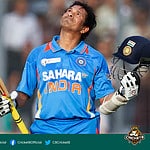Introduction
In the annals of Indian cricket history, few moments have captured the imagination of fans quite like Virender Sehwag’s extraordinary triple century against Pakistan. On that fateful day in Multan, March 29, 2004, Sehwag etched his name in the record books as the first Indian batsman to score a triple century in Test cricket. With his audacious strokeplay and fearless approach, Sehwag revolutionized the batting mindset in the longest format of the game. This article delves into the remarkable journey of Sehwag’s innings, exploring his rise to prominence, the significance of his triple century, and the lasting impact it had on Indian cricket.
Early Struggles and Determination
Sehwag’s journey to cricketing greatness was anything but conventional. Hailing from Najafgarh, a suburb of West Delhi, he grew up in an environment dominated by wrestling, far removed from the cricketing spotlight. However, Sehwag’s passion for the sport burned brightly, and he was determined to make a mark. His coach, Amar Nath Sharma, recognized his immense talent and believed that given the right platform, Sehwag could reach great heights.
Finding a Mentor and Overcoming Obstacles
Sehwag’s breakthrough moment came when he found a mentor in Satish Sharma, a modest cricketer who ran the Madras Club. It was under Sharma’s guidance that Sehwag’s game flourished, and he honed his skills to perfection. However, his path to success was not without its challenges. Sehwag was initially turned away from the under-16 trials by the Delhi and District Cricket Association (DDCA). This setback only fueled his determination to prove himself and work harder.
The Debut and Early Promise
Sehwag’s first-class debut on a treacherous pitch in Rohtak in 1997-98 showcased his immense potential. Despite the difficult conditions, he displayed a free-flowing style of batting that would become his trademark. The cricket authorities in Delhi took note of his talent and, years later, decided to honor him by naming one of the gates of the newly constructed Kotla Stadium after him.
Sehwag’s Triple Century Against Pakistan in Multan
Day 1: A Blistering Start
The first Test against Pakistan in Multan began with India winning the toss and opting to bat first. Sehwag wasted no time in making his presence felt, playing a fluent innings right from the start. On the first day, he remained unbeaten on 228, as India finished at a commanding total of 356/2.
Day 2: A Historic Milestone
As the second day dawned, Sehwag’s assault on the Pakistani bowlers continued unabated. With Sachin Tendulkar providing steady support at the other end, Sehwag reached the milestone of a triple century with his signature aggressive style of play. It was a moment of sheer brilliance when he smashed a six off Saqlain Mushtaq’s bowling to become the first Indian batsman to achieve this feat.
Rewriting Records and Creating History
Sehwag’s triple century not only secured his place in the record books but also propelled India to their highest-ever score against Pakistan. His monumental knock of 309 runs off just 375 balls included 39 boundaries and 6 towering sixes. The partnership between Sehwag and Tendulkar, which amounted to a staggering 336 runs, set the stage for an emphatic Indian victory.
Impact and Legacy
The significance of Sehwag’s triple century against Pakistan cannot be overstated. It was a watershed moment in Indian cricket, marking a shift in mindset and approach. Sehwag’s audacious strokeplay and fearless attitude inspired a generation of cricketers to embrace aggression and express themselves freely on the field. His innings also paved the way for future Indian batsmen to play with a similar attacking mindset, which would prove instrumental in the team’s success in the years to come.
Conclusion
Virender Sehwag’s triple century against Pakistan in Multan remains an indelible chapter in the history of Indian cricket. His fearless approach and audacious strokeplay revolutionized the art of batting in Test cricket. Sehwag’s memorable innings not only rewrote records but also left an indelible impact on the sport, inspiring generations of cricketers to adopt a more attacking mindset. His legacy as one of India’s greatest batsmen and a true trailblazer will continue to inspire future generations to push the boundaries of what is possible on the cricket field.


